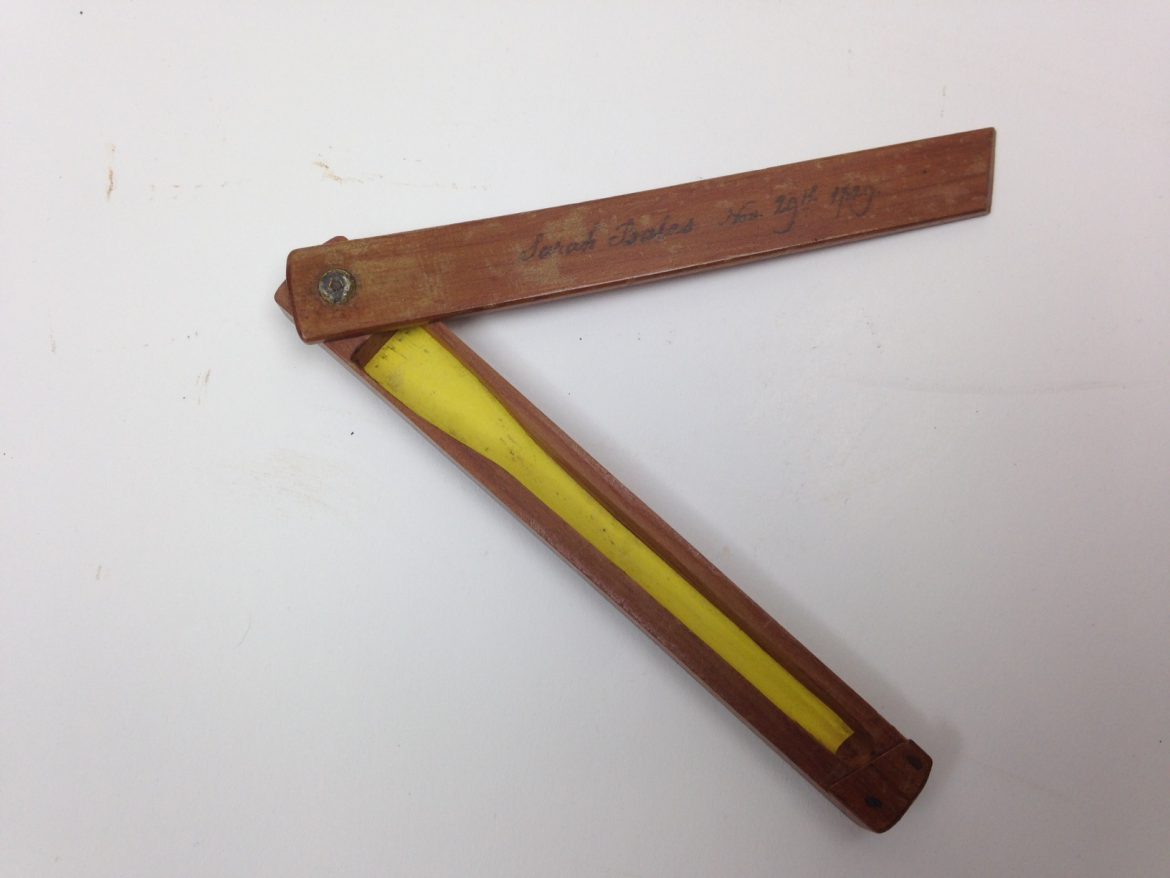
Case for Music Staff Pen, Church Family, Mount Lebanon, NY, 1829, Shaker Museum | Mount Lebanon, 1960.11613.1
Edward Langford came to live at the Church Family at Mount Lebanon at age 11, but eloped in 1892 with Inez Platt, a 20-year old sister who lived at the Second Family. Almost 70 years later, Shaker Museum | Mount Lebanon received from relatives of the Langfords a small box, which at the time of the […]
Edward Langford came to live at the Church Family at Mount Lebanon at age 11, but eloped in 1892 with Inez Platt, a 20-year old sister who lived at the Second Family.

Case for Music Staff Pen, Church Family, Mount Lebanon, NY, 1829, Shaker Museum | Mount Lebanon, 1960.11613.1
Almost 70 years later, Shaker Museum | Mount Lebanon received from relatives of the Langfords a small box, which at the time of the gift held a single ivory toothpick. The bottom of the box is made of a single piece of wood, hollowed out to create the cavity that held the toothpick. The cavity is only one-quarter inch wide at one end but widens abruptly, one and one-half inches from the other end to just over one-half inch. It took a number of years and the appearance of other such boxes to understand that it was not made to hold a toothpick but rather was the case for a Shaker rastrum. Rastrums are pens with multiple points used to scribe lined staffs for music manuscripts. The Shakers wrote down thousands of their unique songs, hymns, and anthems using a music system in which the letters “a” through “g,” instead of the now-common round notes, were written on a standard four or five line staff. This box once held one of these pens. The bottom of the cavity is lined with a brilliant yellow paper and at the wide end of the paper it is possible to see five small evenly-spaced dots where the five tips of the pen came to rest when place in its case.

Music Staff Pen and Case, Church Family, Mount Lebanon, NY, ca. 1820s, Private Collection.
Several of these pens have letterpress printed instructions pasted either on the outside of the case or inside the cavity, as shown here in an example from a private collection. “This pen may be used either side up: – but if it will not make good lines without bearing on too hard, it needs some repair.” This instruction is followed by the initials “I. N. Y.” Brother Isaac Newton Youngs (1793-1865) lived at the Church Family at Mount Lebanon from 1807 until his death. Brother Isaac is described by a Shaker brother and friend in a eulogy, “His mechanical genius was remarkable. In him was combined, The Carpenter, Cabinetmaker, Clock and Watch-maker; which obligation he filled to the last. He many years did the Tailoring, and when needed, could turn Machinest, Mason, or anything that could promote the general good. Very many of our little conveniences which added so much to our domestic happiness owe their origin to Brother Isaac…” Much of Brother Isaac’s success in making those conveniences (and much of what, at times, made him challenging for others) was his commitment to perfection and precision.
Brother Isaac was also, for many years, the family scribe – keeping the daily family journal, spiritual records, and correspondence. He had a passionate interest in music and made special efforts to standardize Shaker singing. Shakers did not use musical instruments to keep them on pitch during Brother Isaac’s lifetime. To keep the Shakers “in union” so they would all sing the same music in the same way, he likely developed two instruments – one, a toneometer, used to set the pitch, and a modeometer, used to set the speed. In 1843 he printed a small book of music instruction to help others understand these concepts and to teach the Shaker system of letter-notation.

Music Staff Pen, Church Family, Mount Lebanon, NY, ca. 1835, Private Collection. Purchased at Willis Henry Auction 2013, Lot 77.
The five-pointed music pen – a tool he would have found most useful in recording hundreds, if not thousands, of Shaker songs – seems a natural outgrowth of his precise mechanical nature, his obligation to record keeping, and his interest in music. Brother Isaac was also skilled in making the pens from coin silver sold by Shakers at Mount Lebanon and Watervliet. Another example from a private collection is shown above.
While the pen itself remains missing, its case provides more about its history. On the outside of the case is written, “Sarah Bates Nov. 29th 1829.” Sister Sarah Bates was also a resident at the Church Family. She and Brother Isaac were nearly the same age. She was born November 29, 1792; Isaac was born July 4, 1793. Both first lived at the Shakers’ Watervliet community, Isaac beginning his life at the Church Family at Mount Lebanon in 1807 and Sister Sarah coming there in 1811. Sister Sarah Bates was a school teacher, likely a scribe for the family, and is known to have written several songs. It seem perfectly reasonable that Brother Isaac made a music pen and its case for Sister Sarah and the fact that it is dated on her thirty-seventh birthday suggests it was a very useful gift. It’s not known how Edward Langford or his descendants came into possession of the box.
More than a half-dozen of Brother Isaac’s music pens survive in private and public collections. There is always some hope that someday a Shaker rastrum, if not THE Shaker rostrum that once filled this case, might complete this story for Shaker Museum | Mount Lebanon.